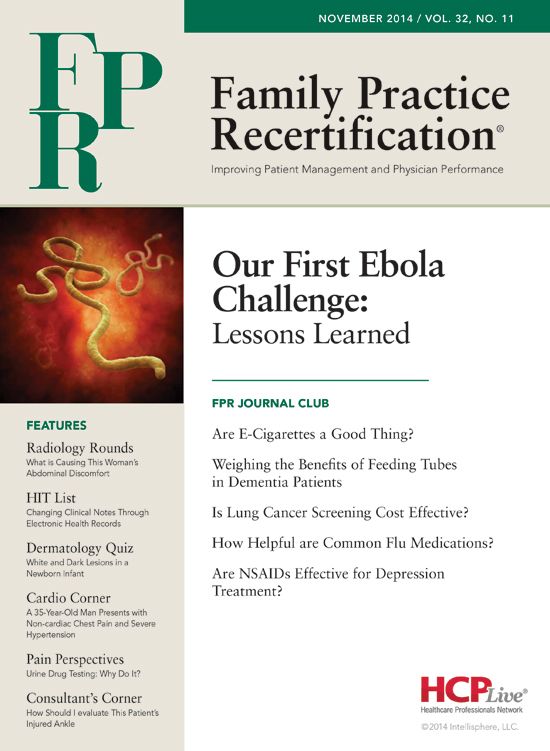Publication
Article
Family Practice Recertification
Urine Drug Testing: Why Do It?
Author(s):
Many clinicians and academicians believe that stipulation for random urine drug testing should be a part of any opioid agreement, with UDT serving the dual purposes of ensuring compliance with prescribed opioids as well as monitoring use of illicit drugs and non-prescribed medications.

Michael Schatman, PhD, CPE
Last month’s Pain Perspectives addressed the benefit of opioid agreements as an aspect of sound and prudent opioid prescribing. Many clinicians and academicians believe that stipulation for random urine drug testing (UDT) should be a part of any opioid agreement (1), with UDT serving the dual purposes of ensuring compliance with prescribed opioids as well as monitoring use of illicit drugs and non-prescribed medications (2).
In the modern era, UDT has its roots in the random testing of American soldiers to ensure abstinence from recreational drugs (3). The practice of drug screens in pain medicine was uncommon until the late 1990s, when a groundbreaking study by Fishbain and colleagues (4) determined that a significant proportion of patients with chronic pain were providing inaccurate information regarding their utilization of illicit drugs. Several years later Katz and Fanciullo performed a review on UDT (5), and concluded that it should be conducted routinely in patients with chronic pain being treated with opioids.
Despite being recommended in a number of pain management guidelines (6-8), research has indicated reluctance among many clinicians to conduct UDT. For example, in a 2001 study of primary care physicians treating chronic pain (9), only 8% were utilizing urine toxicology screens. In a 2006 study of primary care physicians (10), only 6.9% reported conducting UDT prior to prescribing and only 15% conducted testing on patients already prescribed opioids.
In a more recent article on the use of opioid risk reduction strategies in primary care (11), the authors determined that only 8% of patients receiving opioids received at least one UDT with only 24.4% of patients deemed to be at the highest risk receiving any urine toxicology screening. These figures are quite disturbing, particularly in light of the data that indicate that the prevalence of substance use disorders is 4 times higher among patients receiving opioid therapy than in the general population (12) and that as many as 44.6% of all patients with chronic pain prescribed opioids demonstrate at least some drug-related aberrant behavior (13).
It is important to consider what is not in the urine of patients prescribed opioids as well as what is in their urine. Much of the current opioid abuse crisis is due to diversion, and although “doctor shoppers” are often considered the primary perpetuators of diversion (14), data indicate that we cannot be too careful with any group of patients. Even populations that would not necessarily be thought to be at risk, such as seniors (15) and adolescents involved in organized sports (16), have been found to be at risk for diversion. When a urine drug test is negative for the prescribed opioid(s) in a patient who claims to be taking his/her opioids as prescribed, diversion certainly becomes a distinct possibility.
The bottom line is that urine drug testing is an important tool that should be used by all physicians whose pain management treatment regimens include chronic opioid therapy. For many years, UDT was extremely profitable for physicians, and was frequently abused as a means of increasing revenue (17). However, changes in the law (18) mandate that UDT is neither a profit generator nor a financial burden to the practitioner. Rather, it is a practice that will help save your patients’ lives, the lives of others in society, and protect your practice. In this era of DEA and state medical board scrutiny, the physician who exercises caution by requiring appropriate UDT is the legal, ethical, and effective pain manager.
I hope that you’ve found the information presented here thought-provoking. In next month’s column, I will address the important issue of how to effectively utilize UDT as an aspect of your pain management practice.
REFERENCES
1) Jamison RN, Serraillier J, Michna E. Assessment and treatment of abuse risk in opioid prescribing for chronic pain. Pain Res Treat. 2011;2011:941808.
2) Cone EJ, Kaplan YH, Black DL, et al. Urine drug testing of chronic pain patients: licit and illicit drug patterns. J Anal Toxicol. 2008;32:530-543.
3) Bray RM, Marsden ME, Rachal JV, Peterson MR. Drugs in the military workplace: findings from the 1988 world-wide survey. NDA Res Monogr. 1990;100:25-43.
4) Fishbain DA, Cutler RB, Rosomoff HL, Rosomoff RS. Validity of self-reported drug use in chronic pain patients. Clin J Pain 1999;15:184-191.
5) Katz N, Fanciullo GJ. Role of urine toxicology testing in the management of chronic opioid therapy. Clin J Pain 2002;18(4 Suppl):S76-S82.
6) Chou R, Fanciullo GJ, Fine PG, et al. Clinical guidelines for the use of chronic opioid therapy in chronic noncancer pain. J Pain 2009;10:113-130.
7) Manchikanti L, Abdi S, Atluri S, et al. American Society of Interventional Pain Physicians (ASIPP) guidelines for responsible opioid prescribing in chronic non-cancer pain: part I — evidence assessment. Pain Physician 2012;15(3 Suppl):S1-S65.
8) American College of Occupational and Environmental Medicine. Guidelines for chronic use of opioids. Available at: http://www.acoem.org/Guidelines_Opioids.aspx. Accessed on November 9, 2014.
9) Adams NJ, Plane MB, Fleming MF, et al. Opioids and the treatment of chronic pain in a primary care sample. J Pain Symptom Manage. 2001;22:791-796.
10) Bhamb B, Brown B, Hariharan J, et al. Survey of select practice behaviors by primary care physicians on the use of opioids for chronic pain. Curr Med Res Opin. 2006;22:1859-1865.
11) Starrels JL, Becker WC, Weiner MG, et al. Low use of opioid risk reduction strategies in primary care even for high risk patients with chronic pain. J Gen Intern Med. 2011;26:958-964.
12) Fleming MF, Balousek SL, Klessig CL, et al. Substance use disorders in a primary care sample receiving daily opioid therapy. J Pain 2007;8:573-582.
13) Passik SD, Kirsh KL, Whitcomb LA et al. A new tool to assess and document pain outcomes in chronic pain patients receiving opioid therapy. Clin Ther. 2004;26:552—561.
14) McDonald DC, Carlson KE. Estimating the prevalence of opioid diversion by “doctor shoppers” in the United States. PLoS One 2013;8:e69241.
15) Levi-Minzi MA, Surratt HL, Kurtz SP, Buttram ME. Under treatment of pain: a prescription for opioid misuse among the elderly? Pain Med. 2013;14:1719-1729.
16) Veliz PT, Boyd CJ, McCabe SE, et al. Medical use, medical misuse, and diversion of opioids among adolescents involved in organized sport. Drug Alcohol Depend. 2014;140:e233.
17) Collen M. Profit-driven drug testing. J Pain Palliat Care Pharmacother. 2012;26:13-17.
18) Bolen J. Want to minimize the potential for a fraud and abuse investigation of your drug testing practices? Then take control of your testing platform and clinical laboratory partner. Published December 3, 2010. Auditing for Compliance and Education, Inc. (ACE). Available at: http://www.aceanesthesiapain.com/Portals/0/UDS%20Article%20by%20Jennifer%20Bolen.pdf. Accessed on November 9, 2014.
About the Author
Michael E. Schatman, PhD, CPE, is a clinical psychologist who has spent the past 27 years working in pain management. He is currently the Executive Director of the Foundation for Ethics in Pain Care in Bellevue, WA, where he also maintains a part-time practice in pain psychology. Schatman is the author of more than 80 peer-reviewed and invited journal articles and book chapters on pain management, and he lectures regularly on both local and national bases. He is the editor of Ethical Issues in Chronic Pain Management and Chronic Pain Management: Guidelines for Multidisciplinary Program Development, both of which were released in 2007. Currently, he is Editor-in-Chief of the Journal of Pain Research, Ethics Section Head Editor of Pain Medicine and Psychological Injury & Law, and Deputy Editor-in-Chief of the International Journal of Cannabinoid Medicine. Schatman serves on the Board of Directors of the American Society of Pain Educators, which named him 2011 Clinical Pain Educator of the Year.






